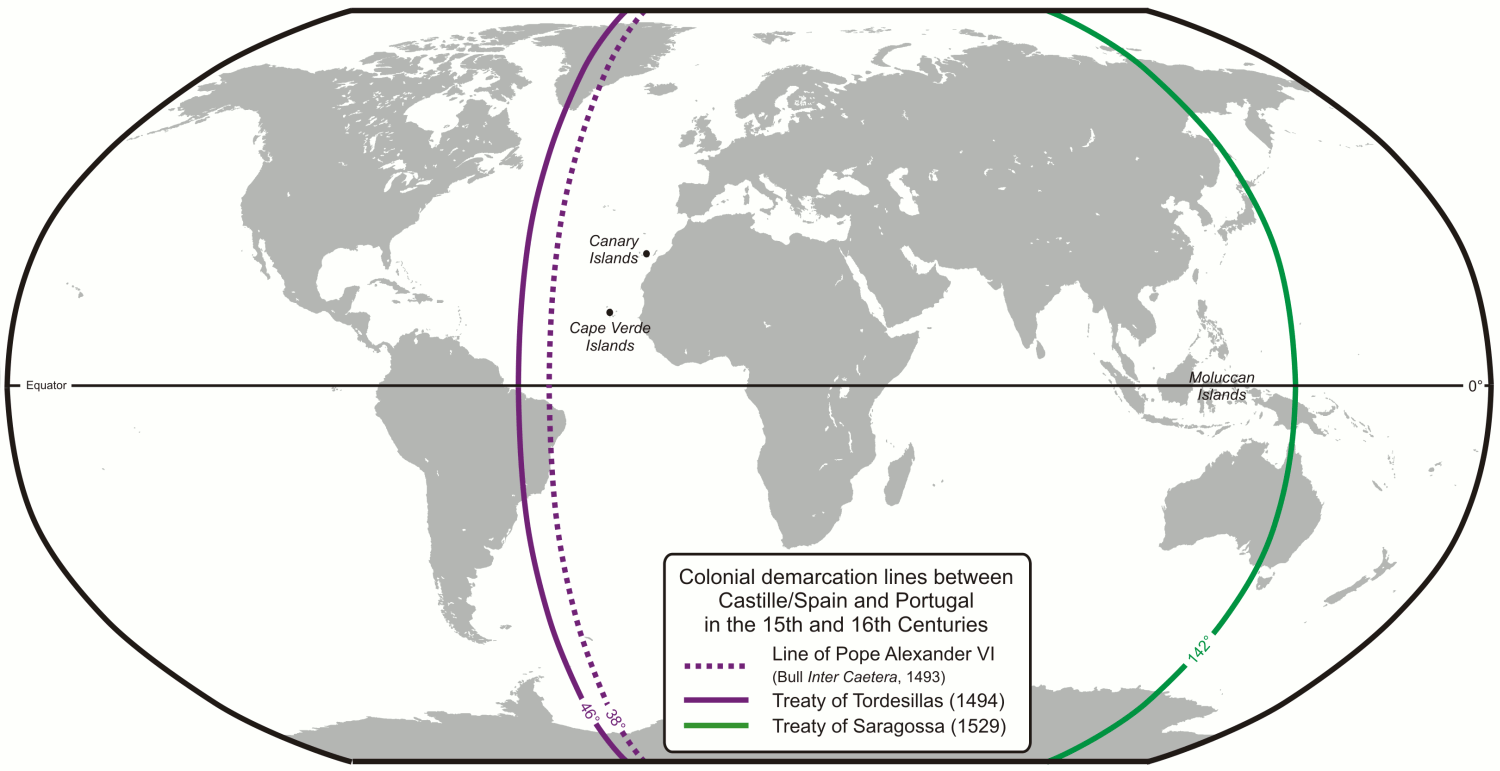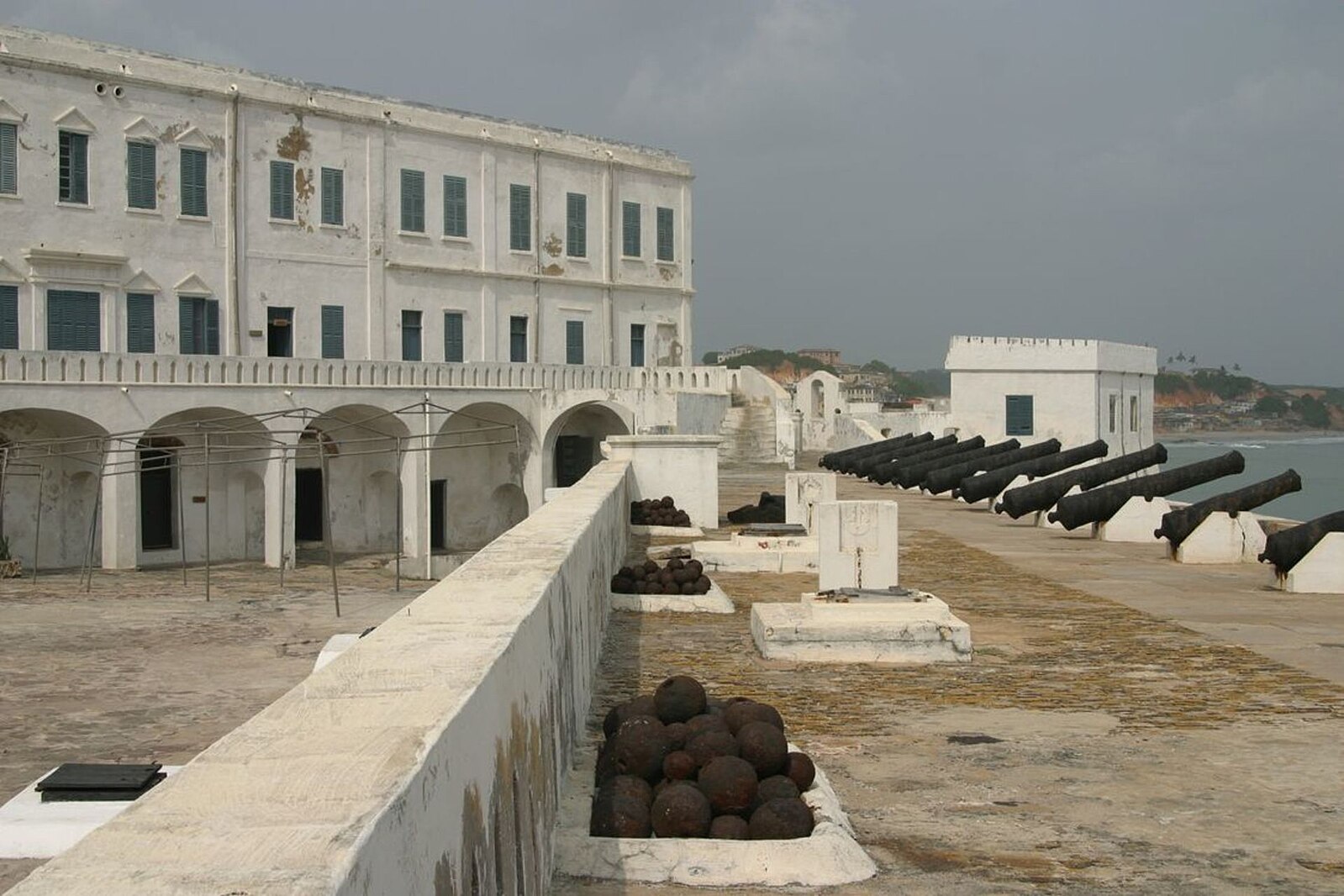OCR Specification focus:
‘The Treaty of Tordesillas (1494); encounters by Portugal: Atlantic and Americas, Africa, Asia.’
Introduction
The Treaty of Tordesillas and Portuguese overseas encounters reshaped world exploration, establishing political dominance, territorial claims, and commercial routes that influenced Europe and global empires.
The Treaty of Tordesillas (1494)
The Treaty of Tordesillas was a landmark diplomatic agreement between Spain and Portugal, mediated under papal influence, which divided the newly discovered lands outside Europe.
Origins of the Treaty
In 1493, Pope Alexander VI issued a series of papal bulls (notably Inter caetera) granting Spain dominion over lands west of a demarcation line.
Portugal, a leading maritime power, objected to this allocation, fearing it limited their access to valuable overseas territories.
Negotiations between the two powers produced the Treaty of Tordesillas in 1494.
Main Terms of the Treaty
The division line was set at 370 leagues west of the Cape Verde Islands.

Map showing the 1494 Treaty of Tordesillas meridian dividing spheres of Spanish and Portuguese expansion. The 1529 Treaty of Zaragoza antimeridian is also included. Source
Spain received rights to territories west of the line, while Portugal was granted those to the east.
This arrangement effectively split the non-European world between the two powers.
Treaty of Tordesillas: An agreement signed in 1494 between Spain and Portugal dividing new lands outside Europe into separate spheres of influence along a fixed meridian.
The treaty not only avoided conflict between Spain and Portugal but also provided a legal and religious justification for European colonisation, sanctioned by the Catholic Church.
Portuguese Encounters in the Atlantic and the Americas
Although Spain came to dominate the Americas, Portugal also made early encounters.
Atlantic Explorations
Portuguese navigators had already discovered and settled Madeira and the Azores in the early 15th century.
They established plantations producing sugar, which became a lucrative economic model later transplanted to Brazil.
Brazilian Settlement
In 1500, Pedro Álvares Cabral made landfall on the Brazilian coast.
Under the Treaty of Tordesillas, this region fell within Portugal’s sphere, leading to long-term settlement and economic exploitation.
Brazil became a major Portuguese colony, initially focused on timber (pau-brasil) and later on sugar plantations, which relied heavily on enslaved labour.
Portuguese Encounters in Africa
Portuguese expansion into Africa was central to their imperial and commercial ambitions.
West African Coast
From the 1440s onwards, Portugal established trading posts along the Gold Coast (modern Ghana).
They traded for gold, ivory, and increasingly slaves, laying the foundations of the transatlantic slave trade.
Strategic Fortresses
The construction of Elmina Castle (1482) on the Gold Coast gave Portugal a fortified base to secure trade routes.

Photograph of Elmina Castle on Ghana’s coast, illustrating a typical Portuguese fortified trading post designed to secure commerce. The bastions and sea-facing walls highlight its defensive design. Source
These forts acted as staging posts for further exploration into the Indian Ocean.
Feitoria: A Portuguese fortified trading post established overseas to secure commercial and military interests.
By maintaining these feitorias, Portugal created a network of controlled exchange points rather than large-scale territorial conquest in Africa.
Portuguese Encounters in Asia
Asia was the ultimate prize for Portuguese expansion, offering direct access to spices, silks, and luxury goods.
Indian Ocean Exploration
In 1498, Vasco da Gama reached Calicut (modern Kozhikode, India), opening the sea route to India.
This voyage bypassed traditional Muslim and Venetian intermediaries, granting Portugal control of lucrative spice trade routes.
Key Conquests and Settlements
Portuguese established bases at Goa (1510) in India, Malacca (1511) in Southeast Asia, and later Macao (1557) in China.
These bases enabled Portugal to dominate maritime choke points and secure trade networks across Asia.
Methods of Control
Portuguese influence was less about territorial conquest and more about:
Naval superiority, allowing them to control key sea lanes.
Fortified settlements ensuring defence and authority over commerce.
Cartaz system, whereby merchant ships required Portuguese-issued passes to trade legally.
Cartaz: A Portuguese naval licence issued in the Indian Ocean during the 16th century, compelling non-Portuguese ships to pay fees and acknowledge Portuguese authority.
By establishing feitorias and garrisons (fortified trading posts), Portugal aimed to channel commerce through its cartaz (safe-conduct pass) and levy customs at chokepoints (Hormuz, Goa, Malacca).
Wider Impact of Portuguese Encounters
The Portuguese encounters across three continents reshaped global connections.
Economic Outcomes
Established the first global maritime empire, linking Europe, Africa, Asia, and South America.
Controlled the spice trade, sugar production, and slave trade, fuelling Portugal’s wealth.
Religious Motivations
The Portuguese monarchy saw expansion as part of a Christian mission to spread Catholicism.
Missionaries accompanied expeditions, particularly Jesuits in Asia, blending trade with spiritual conquest.
Geopolitical Significance
The Treaty of Tordesillas marked the beginning of formal European colonial boundaries, though it largely ignored other European powers.
Portuguese success inspired rival nations, including Spain, France, and England, to launch their own overseas ventures.
Difficulties Encountered
Resistance from indigenous populations, such as in India and East Africa.
Competition with established Muslim trading networks.
Logistical challenges of maintaining long-distance supply lines.
In summary, the Treaty of Tordesillas (1494) and Portuguese encounters in the Atlantic, the Americas, Africa, and Asia illustrate Portugal’s pioneering role in creating an interconnected global empire and set the stage for centuries of European overseas expansion.
FAQ
Portugal feared the papal bulls of 1493 restricted their established maritime sphere in Africa and the Indian Ocean.
They had invested decades in exploring the West African coast, building trading posts, and developing navigational expertise.
If Spain gained exclusive rights west of the line, Portugal risked losing access to profitable trade routes and expansion opportunities.
Negotiating the Treaty of Tordesillas secured recognition of Portugal’s eastern routes and future claims, including Brazil.
The treaty did not involve or recognise other European kingdoms, such as England or France.
By granting exclusive rights to Spain and Portugal, it effectively excluded rival powers from sanctioned overseas ventures.
This led to long-term resentment and eventual challenges to Iberian dominance once these nations developed their own naval capacity.
The treaty thus set a precedent for territorial division but lacked universal European acceptance.
Prince Henry the Navigator supported a centre of learning at Sagres in southern Portugal.
Here, cartographers, sailors, and shipbuilders pooled knowledge of winds, currents, and instruments.
Advances included:
Development of the caravel, suited for long voyages.
Mastery of the astrolabe and improved charts.
Understanding of Atlantic wind systems such as the volta do mar.
This knowledge was essential for Portuguese Atlantic settlement and paved the way for Brazil’s eventual discovery.
In Africa, the Portuguese largely relied on feitorias (trading posts) rather than full-scale colonisation.
They prioritised access to gold, ivory, and slaves through negotiated agreements with local rulers.
In the Americas, particularly Brazil, Portugal established plantations and permanent settlements.
This required territorial control, land clearing, and labour exploitation, including enslaved Africans transported from their African trade bases.
Malacca, captured in 1511, controlled the narrow strait linking the Indian Ocean with the South China Sea.
It was the main hub for trade between Southeast Asia, China, and the Middle East.
Holding Malacca allowed Portugal to:
Regulate spice flows from the Moluccas (Spice Islands).
Impose the cartaz system on regional shipping.
Secure a naval base to project power deep into Asia.
Its capture marked Portugal’s transition from coastal trading posts to strategic choke-point dominance.
Practice Questions
Question 1 (2 marks)
What was the purpose of the Treaty of Tordesillas (1494)?
Mark Scheme:
1 mark for stating it was an agreement between Spain and Portugal to divide newly discovered lands.
1 mark for specifying that Spain gained rights to the west of the line and Portugal to the east.
Question 2 (6 marks)
Explain how Portuguese encounters in Africa and Asia supported their overseas empire.
Mark Scheme:
Up to 2 marks for describing African encounters:
Reference to establishing trading posts on the Gold Coast. (1 mark)
Mention of Elmina Castle/fortified feitorias as bases for trade and control. (1 mark)
Up to 2 marks for describing Asian encounters:
Vasco da Gama’s voyage to Calicut opening sea route to India. (1 mark)
Establishment of bases at Goa, Malacca, or Macao. (1 mark)
Up to 2 marks for analysis of how these encounters supported empire:
Controlled key choke points and secured spice trade routes. (1 mark)
Extended Portuguese influence through naval superiority and the cartaz system. (1 mark)
Indicative content for full marks: Answers should combine factual detail (African and Asian encounters) with explanation of how these strengthened Portuguese trade dominance and imperial reach.

